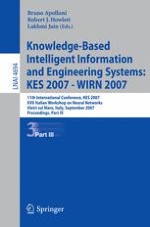2007 | Buch
Knowledge-Based Intelligent Information and Engineering Systems
11th International Conference, KES 2007, XVII Italian Workshop on Neural Networks, Vietri sul Mare, Italy, September 12-14, 2007, Proceedings, Part III
herausgegeben von: Bruno Apolloni, Robert J. Howlett, Lakhmi Jain
Verlag: Springer Berlin Heidelberg
Buchreihe : Lecture Notes in Computer Science
